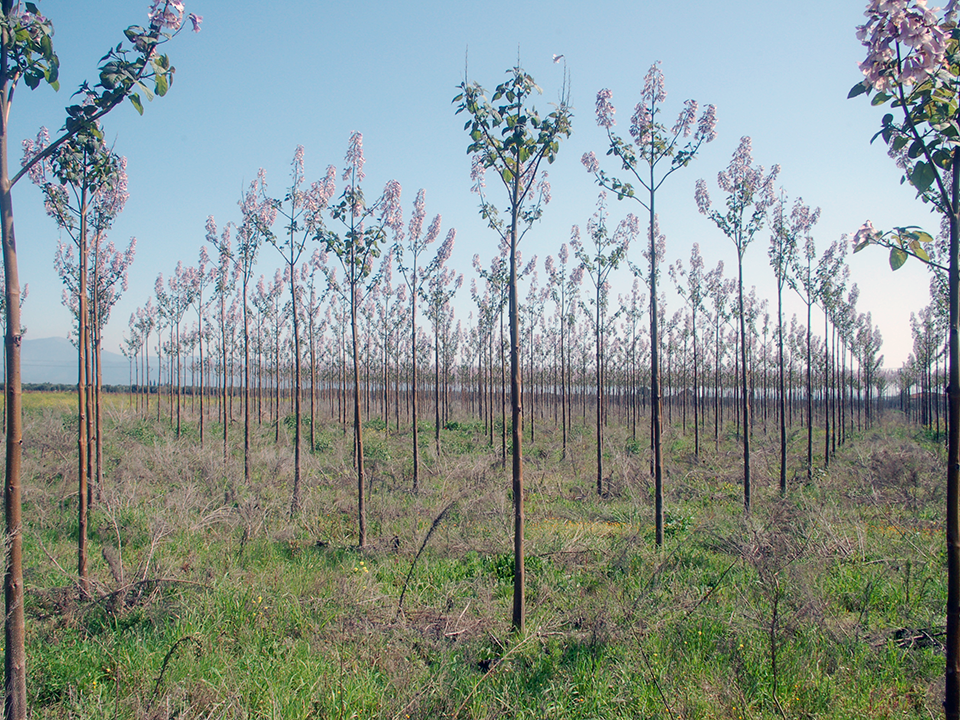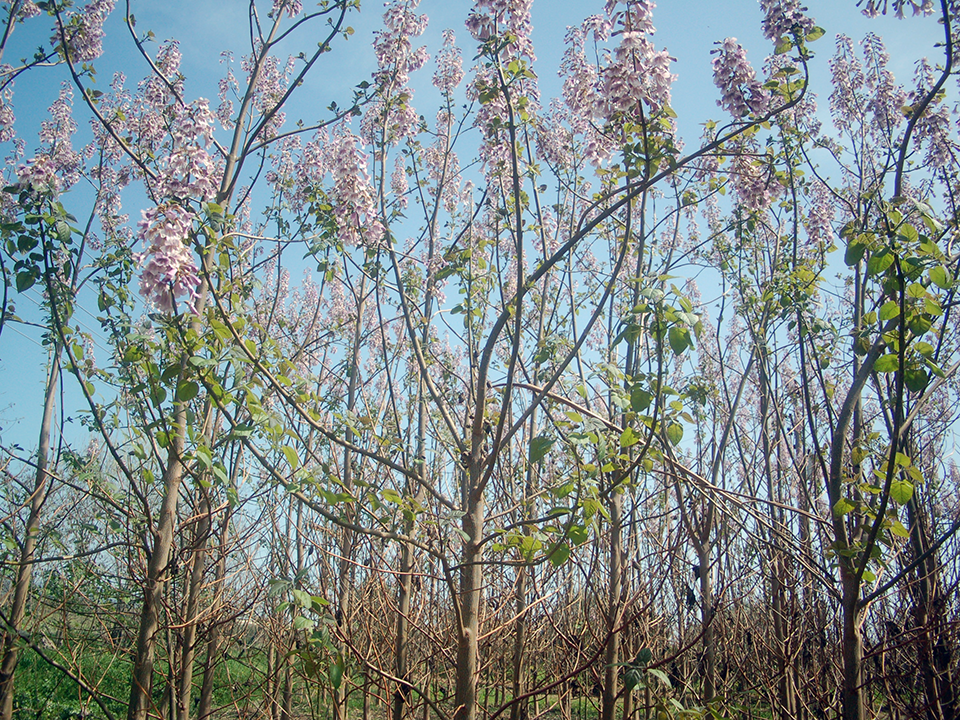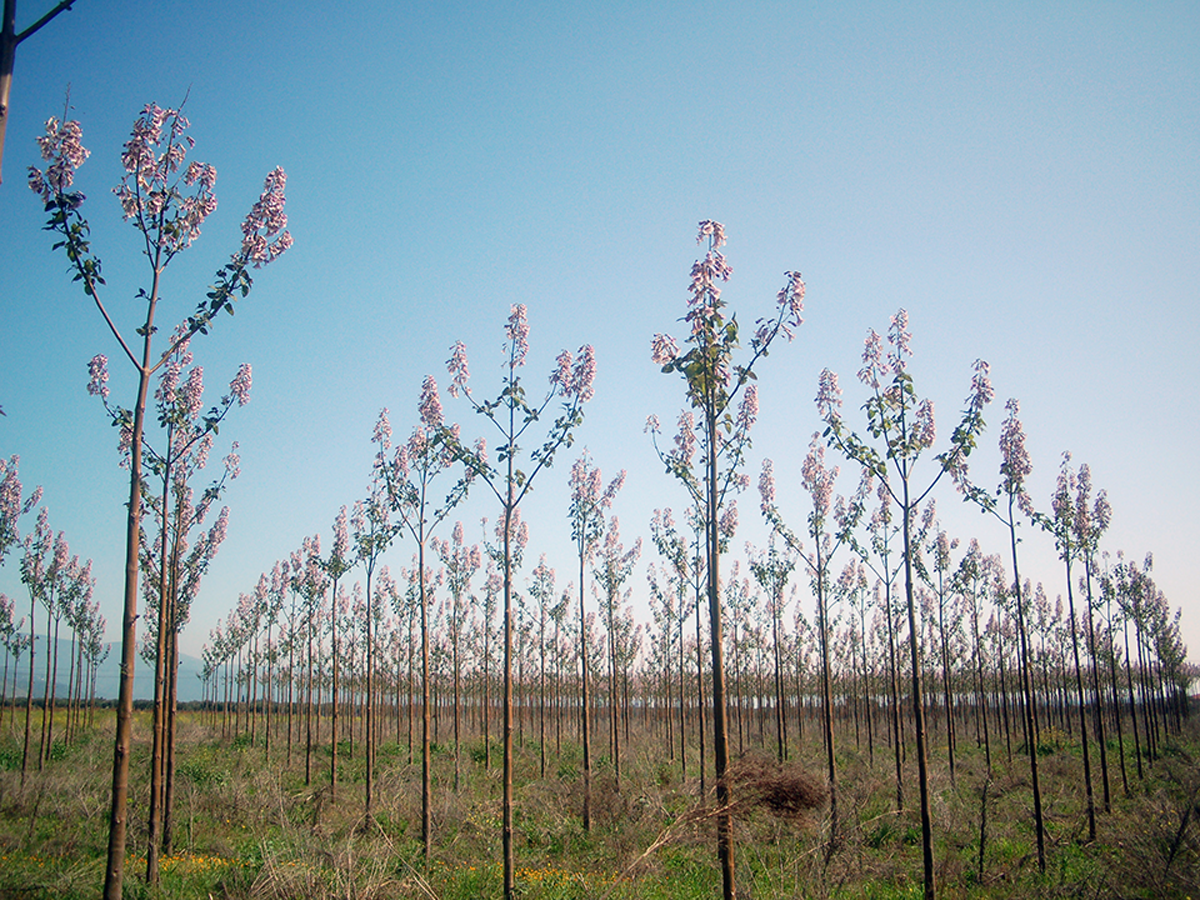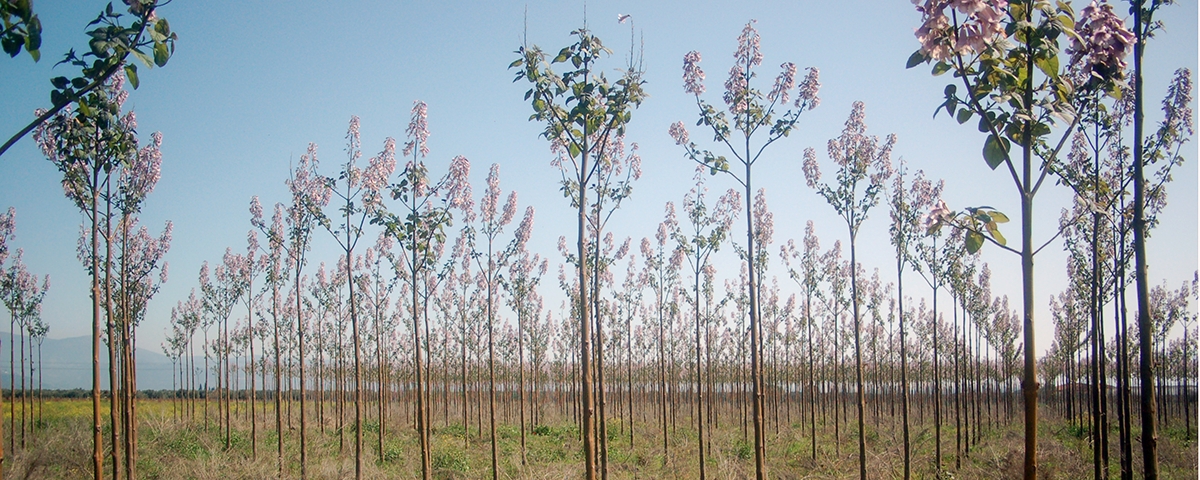Paulownia Cot2 is an improved variety that is imported from Spain and is internationally patented.
Romanas Plant Nursing, as its exclusive representative in Greece, provides this variety with certification (patent no. ΟCPM 2007\1679)
General Information about Paulownia
Paulownia is considered probably the fastest growing tree on earth. The fast and proper development of the tree requires well-drained soil and direct sunlight. The tree can grow in almost all kinds of soil and is resistant to dry spells. The roots spread deep into the ground and thus they can discover the water they need. Therefore, any other plant can develop around Paulownia. Unlike other fast growing species, Paulownia can live between 80 and 100 years. Τhe seedling becomes 1.5-2 m tall and adds to the environment. Paulownia is a deciduous tree that can become very tall. It has been cultivated in China for over 2300 years and for 1000 years in Korea and India. There are nine different species of Paulownia, two of which are cultivated in Australia.
In recent years, environmental disasters and wildfires have resulted in a great shortage of timber and relevant products all over the world because, as the burned forests need several decades to regrow, less timber is available every year.
Therefore, thanks to its fast growth, Paulownia is much more preferred than other trees.
For example, if within a period of 30 years, a tree is felled once or twice and produces 1-2 cubic metres of timber, Paulownia is felled 4-6 times and produces 4-6 cubic metres of timber. This applies to a specific variety of Paulownia, i.e. cot2, which is superior to both the other varieties of Paulownia and fast growing trees in general.
Paulownia is a neutral tree energy-wise, which means that the oxygen released by the tree is equal to the pollution directed to the atmosphere due to its cultivation. This indicates zero environmental pollution.
The tree contributes significantly to rapidly changing the microclimate of the nearby areas, with temperatures quite often dropping at lower levels.
We often hear myths regarding the great expenses that are necessary in order to cultivate Paulownia. However, the cultivation of Paulownia is one of the most profitable all over the world. Its wood is exported all over the world.
According to Japanese tradition, when a couple gives birth to a girl, they plant a Paulownia tree. When the daughter gets married, the family cuts the tree and manufactures a chest in order to put inside the wedding presents that the couple receives.
The Paulownia tree is believed to bring good fortune to the household.
Paulownia provides very short development of trees, while when decorating gardens it provides a perfect aesthetic result with its beauty.
For its speedy and adequate development it needs a well-drained soil, while it should be in sunlit spots. They develop in almost any kind of terrain. In addition, these trees have great endurance in periods of drought. The roots reach deep in the soil and so they can find water on their own. In this way we can plant anything we like around the tree.
Contrary to other speedily developing trees, Paulownia can have a life span of 80 to 100 years. The seedling reaches 1.50 to 2 meters high, is a beautiful presence in the environment, and it is safe for children and pets.
Paulownia is a deciduous tree that can grow very tall. It has been cultivated in China for over 2300 years and for 1000 years in Korea and India. There are nine species of Paulownia, two of which are cultivated in Australia, where they promoted it as a beautiful plant of speedy development.
NATURAL ENVIRONMENT
Paulownia develops naturally in the environmental conditions of China, Taiwan, Cambodia, Laos and Vietnam. Its expansion depends on whether the climate is tropical or cold, the amount of rains and the altitude of the area.
The nine species of Paulownia have very common external characteristics and differ only in cultivation and development characteristics.
REQUIREMENTS FOR TERRAIN AND LOCATION
Paulownia can be developed in a wide range of climates and terrains and its development depends on:
•deep and well-drained soils
•locations with rainfalls or wall-watered
•sunlit places
DEVELOPMENT CONDITIONS
The development of Paulownia depends on the condition, but also on the age of the tree. It can reach 40-50 meters high and trunk diameter larger of 2 meters, although trees under cultivation rarely reach these sizes. For example, in the first year the development of a tree can reach 4 to 6 meters high and another variety may reach 2-3 meters high in places outside China, while the same tree in China it can reach even 10 meters in the first year.
For the production of wood, Paulownia requires intensive care. If we wish to have a large profit from the production of wood it is required to prune certain parts of the tree for speedy development.
Sometimes a more intense pruning is needed in order to correct the stem so it can be straight.
During the first years of development, it is necessary to have a more thorough vigilance in order to avoid the appearance of weeds.
It is necessary to apply ΝΡΚ fertilizer during the development and the planting of the tree. After the stage of initial development the criteria for adding fertilizer to the plant are shaped according to the terrain and climate conditions.
WOOD QUALITY
The wood can be colored from a light yellow to an open red hue. With lower density (260-330 kg / m3 in content, in humidity of 15%) it is soft and odorless. In spite of the low density of the wood, the weight unit is relevantly high, with exceptional qualities of thermal and electrical insulation, but it is unsuitable for use as a structural material with high resistance, due to its low density. Its soft texture allows it to be easily carved, but it should be transferred carefully because it can easily be dented and marked.
In China the wood from Paulownia is used in
furniture
• shipbuilding
• aircrafts
• packaging boxes
• paper
• plywood
• carpentry and casts.
Its green leaves have a great nutritious value for the soil, while they can also be used as a fertilizer.
TECHNICAL CHARACTERISTICS OF THE WOOD
Paulownia wood possesses a variety of characteristics. The pattern of its wood is similar to mahogany or chestnut tree. Its processing has similar characteristics with the one of the red cedar and is not influenced by humidity and termites. The speed of development is shaped according to the climate and terrain conditions of each area. For decades, Japanese craftsmen use this wood in furniture, shoes (clogs), ceremonies, music instruments, decorative casts, constructions and boxes. It is used in transportation due to its light composition and its resistance to nails. Paulownia is approximately 2/3 lighter than any other type of wood. The special weight of Paulownia is from 0,23 to 0,30 (23 to 30% of the water's density).
NATURAL QUALITIES OF Paulownia
- It has a light weight from 280 to 320 kg per cubic meter.
- It dries up in 30-60 days without distortion, crack or tear, while drying up in a furnace lasts for 36-60 hours, depending on the configuration of the furnace.
- It is resistant to deterioration and decay provided that it is not into permanent contact with the soil.
- Resistance to fire is one characteristic of all Paulownia trees, with ignition at a temperature of 420 to 430 degrees Celsius, while an average hard wood ignites at 220 to 225 degrees Celsius.
- Their content in humidity is from 17,8 to 23,2 depending on the variety and the development conditions of the trees.
- Its thermal conductibility is very low providing it with excellent heat-insulating qualities.
- Chemical composition: hemicellulose Pentozan 22-25%, cellulose 46 to 49%, lignin 21-23%, water 7-8%, ash 0,50 - 1,1%, fibers 58,5 to 60,1%.
STRENGTH
Balsa wood has been considered to have the highest resistance compared to its weight from all types of wood all over the world. Paulownia has exceeded Balsa wood in resistance compared to its weight. Researches from the University of Auburn came to the conclusion that the breaking force (psi) of Balsa wood is 2800 psi while for Paulownia is 5740 psi.
The core of Balsa wood is cut in 3/8 of an inch, while Paulownia could be cut in 3/16 of an inch, and as a result they can provide about the same strength and weight.
Paulownia also saves space thanks to its ability to be cut into small pieces.
Paulownia also has a great endurance to nails and screws, although it does not create cracks to its wood when you use nails or screws.
APPLICATIONS
In the East, Paulownia wood is used for manufacturing furniture, music instruments, sculptures and ornaments for more than 1000 years. It is ideal for complex designs, and friendly to jigsaw or band saws, since it does not break up easily. Paulownia was one of the most favorite materials for a lot of engravers in the USA. Furniture, doors and windows can easily be made with its wood, which is also friendly to all veneering materials.
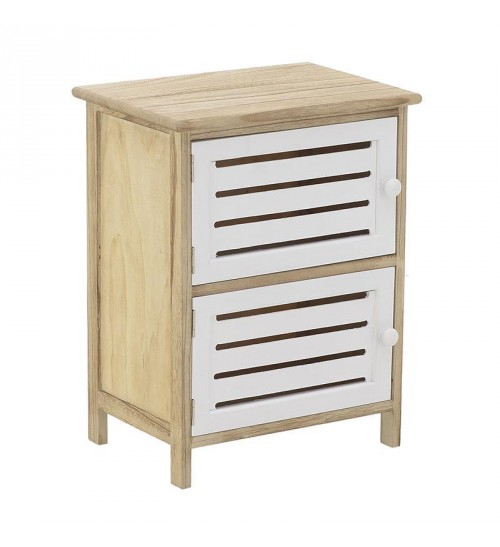
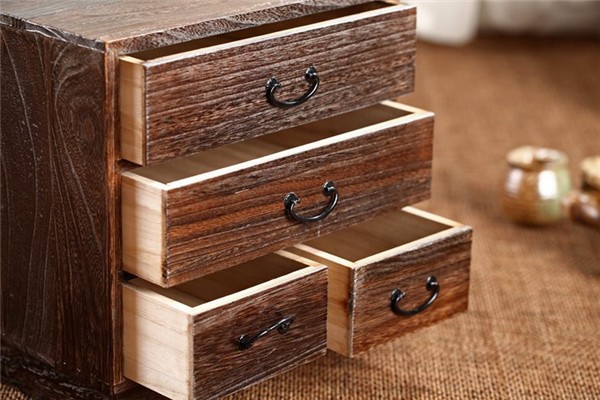
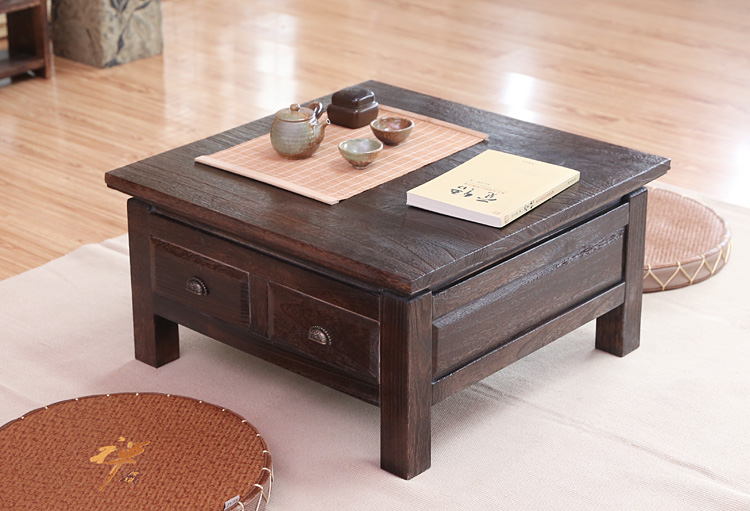

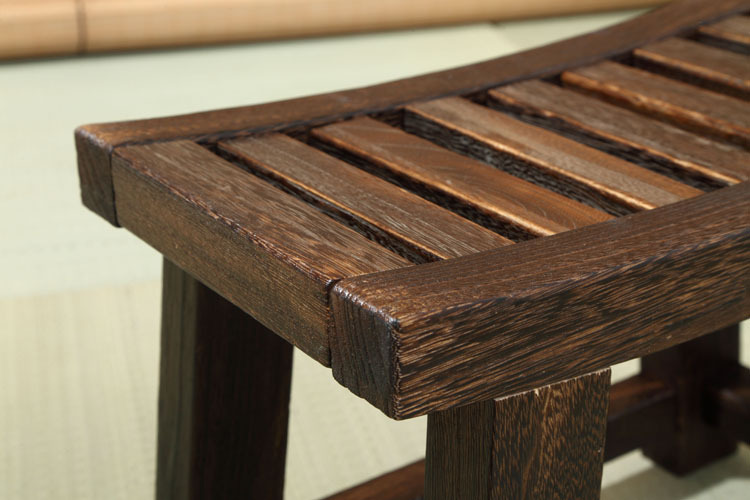
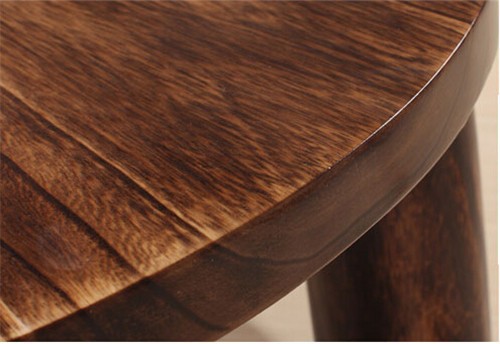
HUMIDITY
Air drying lasts for 30 days, while drying up in a furnace for 10% to 12% content of humidity without being distorted.
Paulownia is not distorted in conditions of humidity or drying up, compared to other trees. It is particularly durable and resistant to decay. Its wood is also resistant to pests.
CONDUCTIVITY
Paulownia wood is an excellent insulation material. The constructions of Paulownia wood have double the coefficient R, compared to pine or oak wood. This coefficient indicates the endurance of the wood in fire and this is proven by the fact that its ignition temperature is approximately 400 C, almost double from conventional types of wood.
APPEARANCE
Paulownia has a slightly blond color, while its gnarls make it look like expensive wood. If it is planed it has a silky, bright texture.
TISSUE CULTURE
During the tissue culture the plants that are reproduced are equally healthy as the plants that are cultivated in a natural way. During the development of the trees of tissue culture the only thing that we have to look for is the adaptation of the tree to the humidity of the soil and the environment, in order for them to become accustomed to conditions of low lighting and warm environment.
BIOTECHNOLOGY
Biotechnology is a very old practice. It started from the time when people understood that they could cultivate their own plants and breed their own animals. Later, when they discovered that wine can be fermented, that milk can turn into cheese or yoghurt, and to process natural raw materials, then started studying biotechnology.
What is biotechnology? In its most simple form, the term biotechnology refers to the improvement of human life and health, through the use of living organisms. In prehistoric time the biotechnologist used yeasts for the fermentation of alcoholic drinks and bacteria in order to make cheese and other dairy products.
Nowadays, with considerable increase of our understanding of biotechnology we can examine various functions of the cells and the organisms. Using DNA techniques, we can combine the genetic elements from two or more living cells, and as a result we have more advanced plants.
